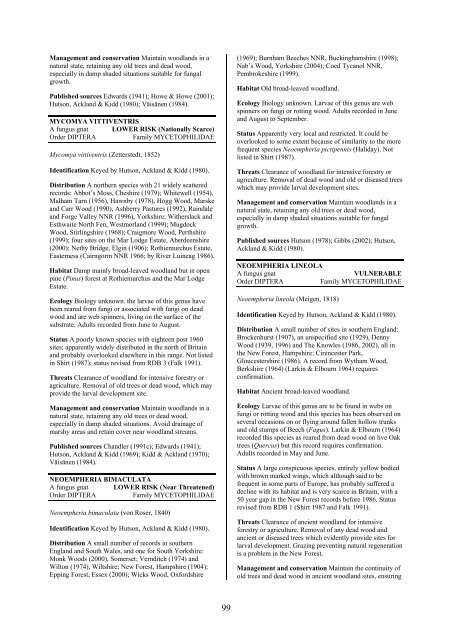Part 2: Nematocera and Aschiza not dealt with by Falk (1991) - JNCC
Part 2: Nematocera and Aschiza not dealt with by Falk (1991) - JNCC
Part 2: Nematocera and Aschiza not dealt with by Falk (1991) - JNCC
You also want an ePaper? Increase the reach of your titles
YUMPU automatically turns print PDFs into web optimized ePapers that Google loves.
Management <strong>and</strong> conservation Maintain woodl<strong>and</strong>s in a<br />
natural state, retaining any old trees <strong>and</strong> dead wood,<br />
especially in damp shaded situations suitable for fungal<br />
growth.<br />
Published sources Edwards (1941); Howe & Howe (2001);<br />
Hutson, Ackl<strong>and</strong> & Kidd (1980); Väisänen (1984).<br />
MYCOMYA VITTIVENTRIS<br />
A fungus gnat LOWER RISK (Nationally Scarce)<br />
Order DIPTERA<br />
Family MYCETOPHILIDAE<br />
Mycomya vittiventris (Zetterstedt, 1852)<br />
Identification Keyed <strong>by</strong> Hutson, Ackl<strong>and</strong> & Kidd (1980).<br />
Distribution A northern species <strong>with</strong> 21 widely scattered<br />
records: Abbot’s Moss, Cheshire (1979); Whitewell (1954),<br />
Malham Tarn (1956), Hawn<strong>by</strong> (1978), Hogg Wood, Marske<br />
<strong>and</strong> Carr Wood (1990), Ashberry Pastures (1992), Raindale<br />
<strong>and</strong> Forge Valley NNR (1996), Yorkshire; Witherslack <strong>and</strong><br />
Esthwaite North Fen, Westmorl<strong>and</strong> (1999); Mugdock<br />
Wood, Stirlingshire (1968); Craigmore Wood, Perthshire<br />
(1999); four sites on the Mar Lodge Estate, Aberdeenshire<br />
(2000); Nethy Bridge, Elgin (1906); Rothiemurchus Estate,<br />
Easterness (Cairngorm NNR 1966; <strong>by</strong> River Luineag 1986).<br />
Habitat Damp mainly broad-leaved woodl<strong>and</strong> but in open<br />
pine (Pinus) forest at Rothiemurchus <strong>and</strong> the Mar Lodge<br />
Estate.<br />
Ecology Biology unknown. the larvae of this genus have<br />
been reared from fungi or associated <strong>with</strong> fungi on dead<br />
wood <strong>and</strong> are web spinners, living on the surface of the<br />
substrate. Adults recorded from June to August.<br />
Status A poorly known species <strong>with</strong> eighteen post 1960<br />
sites; apparently widely distributed in the north of Britain<br />
<strong>and</strong> probably overlooked elsewhere in this range. Not listed<br />
in Shirt (1987); status revised from RDB 3 (<strong>Falk</strong> <strong>1991</strong>).<br />
Threats Clearance of woodl<strong>and</strong> for intensive forestry or<br />
agriculture. Removal of old trees or dead wood, which may<br />
provide the larval development site.<br />
Management <strong>and</strong> conservation Maintain woodl<strong>and</strong>s in a<br />
natural state, retaining any old trees or dead wood,<br />
especially in damp shaded situations. Avoid drainage of<br />
marshy areas <strong>and</strong> retain cover near woodl<strong>and</strong> streams.<br />
Published sources Ch<strong>and</strong>ler (<strong>1991</strong>c); Edwards (1941);<br />
Hutson, Ackl<strong>and</strong> & Kidd (1969); Kidd & Ackl<strong>and</strong> (1970);<br />
Väisänen (1984).<br />
NEOEMPHERIA BIMACULATA<br />
A fungus gnat LOWER RISK (Near Threatened)<br />
Order DIPTERA<br />
Family MYCETOPHILIDAE<br />
Neoempheria bimaculata (von Roser, 1840)<br />
Identification Keyed <strong>by</strong> Hutson, Ackl<strong>and</strong> & Kidd (1980).<br />
Distribution A small number of records in southern<br />
Engl<strong>and</strong> <strong>and</strong> South Wales, <strong>and</strong> one for South Yorkshire:<br />
Monk Woods (2000), Somerset; Vernditch (1974) <strong>and</strong><br />
Wilton (1974), Wiltshire; New Forest, Hampshire (1904);<br />
Epping Forest, Essex (2000); Wicks Wood, Oxfordshire<br />
(1969); Burnham Beeches NNR, Buckinghamshire (1998);<br />
Nab’s Wood, Yorkshire (2004); Coed Tycanol NNR,<br />
Pembrokeshire (1999).<br />
Habitat Old broad-leaved woodl<strong>and</strong>.<br />
Ecology Biology unknown. Larvae of this genus are web<br />
spinners on fungi or rotting wood. Adults recorded in June<br />
<strong>and</strong> August to September.<br />
Status Apparently very local <strong>and</strong> restricted. It could be<br />
overlooked to some extent because of similarity to the more<br />
frequent species Neoempheria pictipennis (Haliday). Not<br />
listed in Shirt (1987).<br />
Threats Clearance of woodl<strong>and</strong> for intensive forestry or<br />
agriculture. Removal of dead wood <strong>and</strong> old or diseased trees<br />
which may provide larval development sites.<br />
Management <strong>and</strong> conservation Maintain woodl<strong>and</strong>s in a<br />
natural state, retaining any old trees or dead wood,<br />
especially in damp shaded situations suitable for fungal<br />
growth.<br />
Published sources Hutson (1978); Gibbs (2002); Hutson,<br />
Ackl<strong>and</strong> & Kidd (1980).<br />
NEOEMPHERIA LINEOLA<br />
A fungus gnat<br />
VULNERABLE<br />
Order DIPTERA<br />
Family MYCETOPHILIDAE<br />
Neoempheria lineola (Meigen, 1818)<br />
Identification Keyed <strong>by</strong> Hutson, Ackl<strong>and</strong> & Kidd (1980).<br />
Distribution A small number of sites in southern Engl<strong>and</strong>:<br />
Brockenhurst (1907), an unspecified site (1929), Denny<br />
Wood (1939, 1996) <strong>and</strong> The Knowles (1986, 2002), all in<br />
the New Forest, Hampshire; Cirencester Park,<br />
Gloucestershire (1986). A record from Wytham Wood,<br />
Berkshire (1964) (Larkin & Elbourn 1964) requires<br />
confirmation.<br />
Habitat Ancient broad-leaved woodl<strong>and</strong>.<br />
Ecology Larvae of this genus are to be found in webs on<br />
fungi or rotting wood <strong>and</strong> this species has been observed on<br />
several occasions on or flying around fallen hollow trunks<br />
<strong>and</strong> old stumps of Beech (Fagus). Larkin & Elbourn (1964)<br />
recorded this species as reared from dead wood on live Oak<br />
trees (Quercus) but this record requires confirmation.<br />
Adults recorded in May <strong>and</strong> June.<br />
Status A large conspicuous species, entirely yellow bodied<br />
<strong>with</strong> brown marked wings, which although said to be<br />
frequent in some parts of Europe, has probably suffered a<br />
decline <strong>with</strong> its habitat <strong>and</strong> is very scarce in Britain, <strong>with</strong> a<br />
50 year gap in the New Forest records before 1986. Status<br />
revised from RDB 1 (Shirt 1987 <strong>and</strong> <strong>Falk</strong> <strong>1991</strong>).<br />
Threats Clearance of ancient woodl<strong>and</strong> for intensive<br />
forestry or agriculture. Removal of any dead wood <strong>and</strong><br />
ancient or diseased trees which evidently provide sites for<br />
larval development. Grazing preventing natural regeneration<br />
is a problem in the New Forest.<br />
Management <strong>and</strong> conservation Maintain the continuity of<br />
old trees <strong>and</strong> dead wood in ancient woodl<strong>and</strong> sites, ensuring<br />
99
















